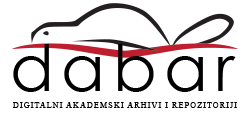| Sažetak | Najvažnija kontrolna varijabla kod vođenja procesa šaržne destilacije je omjer pretoka. U konvencionalnom režimu rada, omjer pretoka se tijekom pokretanja procesa postavlja na maksimalnu vrijednost sve do postizanja stacionarnog sastava, nakon čega ostaje konstantan do završetka procesa. Cilj ovog rada je razviti metodu za određivanje optimalnog vremenskog profila omjera pretoka, počevši od faze pokretanja, kojim se u minimalnom vremenu može proizvesti proizvod zadanih karakteristika.
Za tu svrhu razvijen je matematički model procesa s bezdimenzijskom nezavisnom varijablom. Predložene su dvije metode za rješavanje problema optimalnog vođenja s ciljem minimizacije trajanja procesa. Prva metoda diskretizira omjer pretoka na veliki broj linearnih segmenata, dok druga metoda koristi parametrizaciju manjim brojem jednostavnijih krivulja. Usporedba metoda pri različitim procesnim parametrima pokazala je da metoda s diskretiziranim omjerom pretoka daje najbolje rezultate prema funkciji cilja i minimalnoj eksergijskoj destrukciji, ali je i računalno najzahtjevnija. S druge strane, metoda s parametriziranim profilom omjera pretoka predstavlja dobro kompromisno rješenje, postižući slične rezultate uz znatno smanjenje računalne složenosti. Obje metode omogućuju značajne uštede u odnosu na konvencionalno vođenje procesa, pri čemu potencijalna ušteda varira ovisno o parametrima procesa.
Eksperimentalnim istraživanjem uspješno je validiran razvijeni model u parametriziranom režimu rada. Pokazano je da simulacija može reproducirati eksperimentalne rezultate, kao i da se proces može eksperimentalno voditi na temelju rezultata simulacije. Regresijskom analizom ispitani su glavni i interakcijski utjecaji sedam parametara procesa na karakteristike konvencionalnog i optimalnog vođenja procesa.
Na kraju, razvijene su dvije metode za optimizaciju procesa uz nesigurne parametre i početne uvjete, temeljene na proračunu propagacije nesigurnosti metodom Koopmanovog očekivanja. Prva metoda koristi propagaciju nesigurnosti u unutarnjoj optimizacijskoj petlji, dok druga modificira funkciju cilja, koja se zatim minimizira determinističkom optimizacijom. Obje metode daju slične rezultate, ali je druga metoda računalno učinkovitija. |
| Sažetak (engleski) | Distillation remains one of the most widely used separation processes in the chemical and process industries. Batch distillation stands out as an extremely flexible process, especially suited for processing small quantities of mixtures, as well as for applications where feed and product compositions fluctuate significantly. Industries such as pharmaceuticals, fine chemicals, and specialty chemicals frequently rely on batch distillation due to its adaptability to varying production needs.
Despite these advantages, batch distillation is often less energy-efficient than continuous distillation. The frequent startup and shutdown phases inherent in batch operation contribute to higher energy consumption. Given the rising focus on energy efficiency and sustainable practices, there is a growing need to optimize batch distillation processes. This research focuses on optimizing the reflux ratio, a key control variable in batch distillation, to enhance operational efficiency. In conventional operations, the reflux ratio is set to maximum value during startup until a steady-state composition is achieved, after which it is maintained at a constant value until the end of the process. However, such a simplistic approach leaves substantial room for improvement.
The objective of this study is to develop a method for determining the optimal time-dependent reflux ratio profile, starting from the startup phase. The aim of this optimized control strategy is to produce a product meeting specified purity and recovery requirements in the shortest possible time, thereby enhancing overall process efficiency.
Mathematical Modelling and Optimization Problem
The foundation of this work is the development of a mathematical model for the batch distillation process. The model is built on rigorous mass and energy balance equations and employs a dimensionless independent variable, with process duration included as a parameter. In designing the model, a careful balance is struck between complexity and computational efficiency to ensure its suitability for use in iterative optimization algorithms.
Two distinct iterative methods were proposed to solve the optimization problem:
1.
Discretized reflux ratio method
This method discretizes the reflux ratio profile into a large number of linear segments. The optimization problem is solved by iteratively adjusting the values of these segments using gradient-based optimization techniques. The gradients of the objective function with respect to the control variables are computed using the necessary conditions for optimality.
2.
Parameterized Reflux Ratio Method
In this method, the reflux ratio profile is represented by a smaller number of simpler parametric curves, such as piecewise linear or polynomial functions. By reducing the number of decision variables, this approach lowers the computational complexity. Gradients are computed using automatic differentiation, which is efficient for reduced number of control parameters.
Comparative Analysis of Methods
Both methods were applied to a range of process conditions, which included variations in tray and reflux drum holdup, and product specifications. The discretized reflux ratio method provided the best results in terms of minimizing objective function values and destruction of exergy. However, this method is very computationally intensive. On the other hand, the parametric approach offered a near-optimal solution with significantly reduced computational effort. Both methods demonstrate significant savings compared to the conventional operation, with the potential savings varying substantially depending on the process parameters.
Experimental Validation
To validate the developed model and optimization strategies, an extensive experimental study was conducted. The experimental setup included a pilot-scale batch distillation column equipped with process control and measurement systems. A custom-built software platform was used to implement and monitor the control strategies.
Experiments were conducted for conventional reflux control as well as optimized reflux profiles. The TLZ (total-linear-zero) profile, identified as the most efficient parametrization, was tested alongside other profiles. The experimental results were in excellent agreement with simulation predictions, confirming the model’s accuracy. Additionally, the ability to guide experimental operation using simulation-based control profiles was demonstrated, highlighting the practical applicability of the proposed methods.
Impact of Process Parameters
A detailed regression analysis was conducted to evaluate the influence of seven key process parameters on both optimal and conventional operations. These parameters include product purity, product recovery, initial feed composition, number of trays, tray holdup, reflux drum holdup, and tray efficiency. The analysis revealed that the number of trays had the most significant impact on potential time savings, with higher tray counts enabling greater efficiency gains. Initial feed composition primarily influenced the duration of the optimal process, while reflux drum holdup had the most pronounced effect on conventional process duration. These insights provide a comprehensive understanding of the process dynamics and the factors that govern optimization potential.
Optimization Under Uncertainty
The final phase of the study addresses the challenge of optimizing the batch distillation process under uncertain conditions. In real-world operations, parameters such as feed composition, tray efficiency, and holdup volumes inevitably exhibit a degree of uncertainty. To account for this, two uncertainty-based optimization methods were developed, both leveraging Koopman expectation propagation to quantify the impact of parameter uncertainties.
1.
Direct iterative optimization
In this method, uncertainty propagation is performed within an inner optimization loop. The objective function and constraints are evaluated considering the distribution of uncertain parameters.
2.
Backoff–assisted iterative optimization
This method leverages uncertainty propagation to adjust the objective function, incorporating the impact of uncertainties directly into its formulation. This enables a deterministic optimization approach that remains robust under uncertain conditions.
Both methods were validated through Monte Carlo simulations, which confirmed their effectiveness in providing robust solutions under uncertainty. While both approaches yielded comparable results, the second method demonstrated superior computational efficiency. |

